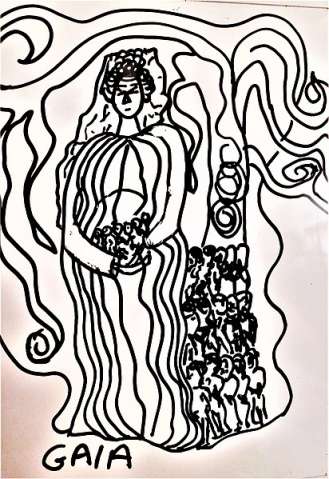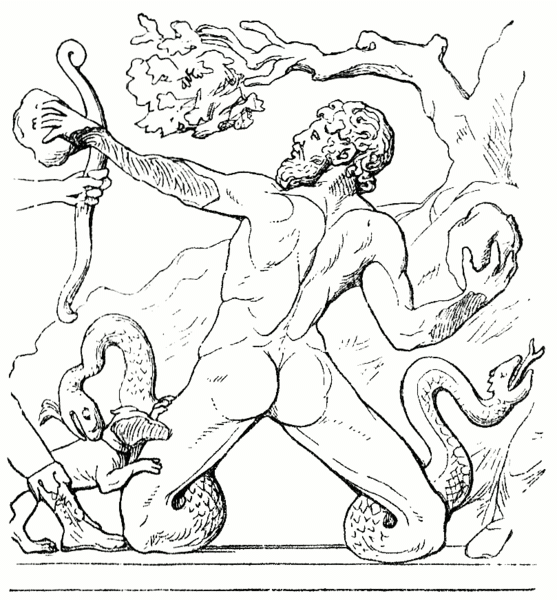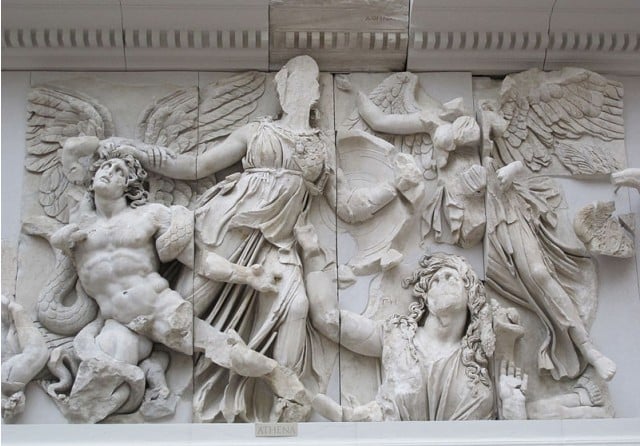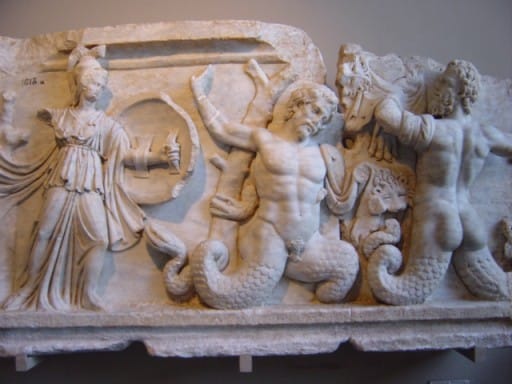In the vast and intricate tapestry of Greek mythology, the Gigantes (or Giants) hold a unique and formidable position. These colossal beings, born from the Earth itself, embody the primal forces of nature and the chaos that precedes order.
Their rebellion against the Olympian gods, known as the Gigantomachy, is a seminal event that showcases the struggle between order and chaos, a theme recurrent in many mythological tales.
Gigantes Key Facts
| Origin | Born from the Earth (Gaia) |
| Creator | Uranus’ blood spilled on Earth |
| Defeated by | Olympian gods with aid of Heracles |
| Habitat | Earth, primarily beneath it |
| Other names | Giants |
| Roman name | Gigantes |
| Associated with | Rebellion against Olympian order |
| Symbols | Large weapons, shields, serpent legs |
Name and Etymology
The name Gigantes is derived from the Greek word ‘gigas’, meaning ‘giant’ or ‘born of the earth’. The etymology reflects their colossal stature and their earthly origin, as they were born from the Earth (Gaia) when the blood of Uranus (Sky) fell upon her. The Romans adopted the name Gigantes, keeping it unchanged in their mythology, which is a testament to the impact and recognition of these beings beyond Greek culture.

The name itself has become synonymous with anything of colossal scale or significance. This linguistic transition and adoption across cultures showcase the universal resonance of the Gigantes’ narrative.
Their epithets and other names often emphasize their monstrous nature and their opposition to the Olympian gods. Each name, each title, carries with it a story, a different shade of meaning, painting a multifaceted picture of these ancient beings, enriching our understanding of their place in Greek mythology.
Gigantes Origin and Creation
According to the myth, they were born from the Earth (Gaia) when the blood of the castrated Uranus (Sky) fell upon her. This union of Sky and Earth, albeit violent, symbolizes the inherent chaos and the primal nature of the Gigantes. Their creation story is a vivid portrayal of the ancient Greek understanding of the cosmos’ tumultuous nature.
The Gigantes were born for a purpose, as instruments of Gaia’s vengeance against the Olympian gods, who had imprisoned her other children, the Titans. Their existence is a direct challenge to the Olympian order, a rebellion against the established divine regime. The Gigantes embody the Earth’s wrath, the natural world’s resistance to the imposed order of the gods.
Their early existence is marked by the Gigantomachy, a cataclysmic battle against the Olympian gods. This event is not just a tale of a battle, but a narrative of the struggle between the old primal forces represented by the Gigantes and the new order symbolized by the Olympian gods. The Gigantomachy is a pivotal event that shapes the narrative of Greek mythology, setting the stage for many other tales and adventures. It’s often suggested that there were a hundred Gigantes, although the exact number may vary depending on the source.
Best known of the Gigantes
- Alcyoneus: Known as the eldest of the Gigantes, who was immortal as long as he remained in his homeland.
- Porphyrion: Often considered the leader of the Gigantes during the Gigantomachy, known for his strength and ferocity.
- Enceladus: Buried under Mount Etna by Athena.
- Polybotes: Known for his enmity with Poseidon, who broke off a piece of the island of Kos and threw it at him.
- Otos and Ephialtes: twin brothers, together known as the Aloadae, they attempted to storm the heavens by stacking mountains atop one another, showcasing their audacious nature and immense strength.
These Gigantes, among others, played significant roles in the myths, showcasing their formidable nature and the challenge they posed to the Olympian gods.
Depiction And Characteristics
Often depicted as colossal humanoid figures with serpent-like legs, the Gigantes embody a visual representation of their earthly origin and monstrous nature. Their size and form actively showcase their primal power and their defiance against the Olympian gods. Particularly, the serpent legs symbolize their deep connection to the chthonic forces of the Earth, serving as a visual cue to their nature and their stark opposition to the heavenly gods.

In art and sculpture, they often wield large rocks and trees as weapons, embodying the raw, untamed forces of nature. Additionally, their attire, or the lack thereof, frequently adorned with animal skins, further underscores their wild, primal nature. The Gigantes’ appearance is not just a visual spectacle but a narrative tool that communicates their essence and their role in the Greek mythological narrative.
Gigantes Nature and Behavior
The nature of the Gigantes is one of rebellion and opposition to the Olympian order. Their actions are driven by the desire to overthrow the gods and reclaim the cosmos for the primal forces they represent. The Gigantes are agents of chaos, embodying the Earth’s wrath against the heavenly gods who had imprisoned her earlier children, the Titans.
Their behavior in myths showcases their relentless pursuit of power and their resistance to the Olympian order. The Gigantes are not just mindless monsters but beings with a purpose, a mission to challenge the gods and reshape the cosmos. Their narrative is a reflection of the ancient Greek understanding of the eternal struggle between order and chaos, a theme that resonates through many mythological tales.
Gigantes Abilities
The Gigantes, boasting immense strength and endurance, truly embody their colossal stature. Often, they are depicted with abilities that match or even surpass those of the gods, showcasing their formidable nature. As beings of the Earth, they exhibit powers that are deeply rooted in the natural world. Not only does this reflect their earthly origin, but it also signifies their opposition to the heavenly gods.
Their ability to challenge the gods showcases the Gigantes as formidable beings, capable of shaking the very foundations of the Olympian order. Their powers are not just physical but symbolic, representing the primal, untamed forces of nature. The Gigantes’ abilities are a narrative tool that communicates their role as challengers to the gods, embodying the ancient Greek understanding of the cosmos’ inherent tumult.
Gigantes Symbols or Associations
Often associated with the raw, untamed forces of nature, the Gigantes embody the chaos and tumult of the natural world. Their symbols, including large rocks, trees, and the serpent legs they frequently sport, vividly represent their earthly origin and primal nature. Moreover, these symbols actively showcase their role as embodiments of nature’s wild side. Additionally, the association of the Gigantes with such elemental symbols underscores their portrayal as agents of natural disorder and tumult.
The serpent legs, in particular, are a powerful symbol of their chthonic nature and their opposition to the Olympian gods. The serpent, a creature of the Earth, symbolizes the Gigantes’ connection to the chthonic forces, their earthly origin, and their challenge to the heavenly order.
Myths about Gigantes
The Gigantes’ tale is not just a story of monstrous beings but a narrative of the struggle between order and chaos. Their rebellion against the Olympian gods, known as the Gigantomachy, is a seminal event in Greek mythology. This battle showcases the Gigantes as formidable adversaries capable of challenging the gods themselves.
Gigantomachy
The Gigantomachy, a cataclysmic battle against the Olympian gods, stands as the most significant myth associated with the Gigantes. This event narrates the struggle between the old primal forces, represented by the Gigantes, and the new order symbolized by the Olympian gods. Moreover, the Gigantomachy serves as a pivotal event that shapes the narrative of Greek mythology, thereby setting the stage for many other tales and adventures.
The battle was fierce and brutal, with both sides suffering great losses. The Gigantes were formidable adversaries, their immense strength and endurance making them a grave threat to the gods. However, with the aid of the hero Heracles, the gods were able to overcome the Gigantes and re-establish their divine order. The Gigantomachy showcases the Gigantes’ formidable nature and their role as challengers to the Olympian order.
The aftermath of the Gigantomachy had lasting repercussions on the Greek mythological narrative. The victory of the Olympian gods symbolized the triumph of order over chaos, a theme that resonates through many other mythological tales. The Gigantes’ defeat marked the end of the old primal forces’ reign and the establishment of the Olympian order, a narrative that shapes the Greek understanding of the cosmos and its inherent order.
Gigantes and Jötnar: A Comparative Exploration
The Gigantes of Greek mythology and the Jötnar of Norse mythology, though rooted in different cultural and mythological frameworks, share a common archetype as primordial beings embodying natural forces and chaos. Both sets of beings represent the ancient, elemental forces that predate the established order of gods.
The Gigantes, born from the Earth, symbolize the primal chaos preceding the Olympian order, while the Jötnar, often associated with elemental forces like ice, fire, and the sea, embody the untamed nature of the Norse cosmos. Their narratives reflect a universal theme of the struggle between order and chaos, a testament to the shared human experience of grappling with the natural world’s unpredictable forces.
However, the portrayal and narrative arcs of the Gigantes and Jötnar diverge significantly within their respective mythologies. Often depicted as adversaries of the Olympian gods, the Gigantes pose a direct challenge to the divine order. This rivalry escalates, eventually culminating in the cataclysmic Gigantomachy.
On the other hand, the Jötnar have a more complex relationship with the Aesir and Vanir gods of Norse mythology. While they are often in conflict, there are instances of alliances, marriages, and progeny between the Jötnar and the gods, showcasing a nuanced interplay between order and chaos. Moreover, the moral and existential undertones in their narratives differ; the Gigantes’ rebellion carries a sense of defiance against a perhaps unjust divine order.
The Jötnar’s interactions with the gods however, often explore themes of fate, destiny, and the inevitable coming of Ragnarok, the end of the world in Norse mythology. Through these contrasting narratives, the Gigantes and Jötnar enrich our understanding of how different cultures perceive and mythologize the natural world and its inherent tumult.
Representations Of Gigantes In Art
The Gigantes have been a popular subject in ancient Greek and Roman art, their colossal forms and epic battles against the gods providing rich material for artistic expression. The Gigantes’ depiction in art is not just a visual spectacle but a narrative tool that communicates their essence and their role in the Greek mythological narrative.

One of the most well-known depictions of the Gigantes prominently adorns the Pergamon Altar, where the Gigantomachy unfolds across a dramatic frieze. This artwork vividly showcases the formidable nature of the Gigantes and their epic struggle against the gods, offering a visual narrative of the battle between order and chaos. Moreover, the Pergamon Altar stands as a testament to the enduring impact and recognition of the Gigantes’ narrative in ancient art and culture.
Their colossal forms, their battles against the gods, and their ultimate defeat are narrative tools that communicate the ancient Greek understanding of the cosmos’ inherent tumult and order.
Mentions in Ancient Texts
The ancient Greek literary tradition is rich in the narrative of the Gigantes, with several foundational texts mentioning them. These texts not only recount the tale of the Gigantes, but also provide a contextual framework. Consequently, they enrich the understanding and interpretation of their story.
Hesiod’s “Theogony”
Hesiod’s work, “Theogony,” is a seminal text. It outlines the Greek cosmogony and theogony, serving as a foundational narrative. In “Theogony,” Hesiod delves into the birth of the Gigantes from Gaia. Furthermore, he recounts their rebellion against the Olympian gods.
A quote from Hesiod’s “Theogony” encapsulates the Gigantes’ essence: “From Gaia sprang the starry Heaven, equal to herself, to cover her on all sides and to be a home forever for the blessed gods. And she bore long Hills, graceful haunts of the goddess-Nymphs who dwell in the hill among the hills. She bore also the fruitless deep with his raging swell, Pontus, without sweet union of love. But afterwards she lay with Heaven and bore deep-swirling Oceanus…”
The Homeric Hymns
The Homeric Hymns, a collection of ancient Greek hymns traditionally attributed to Homer but likely composed by various poets over several centuries (circa 600 to 300 BC), also mention the Gigantes as formidable adversaries of the gods. These hymns are a cornerstone of the Greek literary tradition, showcasing the Gigantes’ role as challengers to the Olympian order and embodying the primal, untamed forces of nature.
Apollodorus’ “Bibliotheca”
Apollodorus of Athens, a scholar and grammarian from the 2nd century BC, compiled a comprehensive work known as “Bibliotheca” or “Library,” which serves as an invaluable source of Greek mythology. In “Bibliotheca,” Apollodorus recounts the Gigantes’ rebellion and the subsequent battle, the Gigantomachy, providing a detailed narrative of this seminal event.
A quote from Apollodorus’ “Bibliotheca” illustrates the Gigantes’ challenge to the gods: “Stirred by the urgings of Gaia, the Gigantes waged a fierce war against the gods, but with the aid of Heracles, they were ultimately vanquished.”
Pindar’s Odes
Pindar, an ancient Greek lyric poet from the 5th century BC, is known for mentioning the Gigantes in his odes. He is celebrated for his elegant and often complex verse. Moreover, Pindar’s odes reflect the religious and moral beliefs of his era. They provide a unique perspective on the Gigantes’ narrative. Additionally, they shed light on their role in the cosmic order.
Frequently Asked Questions
The Gigantes represent the primal forces of nature and the chaos that precedes order. Their rebellion against the Olympian gods is known as the Gigantomachy. This seminal event showcases the struggle between order and chaos. Furthermore, it’s a recurrent theme in many mythological tales.
The Gigantes were born from the Earth (Gaia) when the blood of the castrated Uranus (Sky) fell upon her. Their creation symbolizes the inherent chaos and the primal nature of the ancient Greek cosmos.
Known for their colossal stature, the Gigantes rebelled against the Olympian gods, embodying primal, untamed forces of nature. Moreover, this rebellion highlighted their wild essence, further cementing their legendary status in mythology.
In the fierce Gigantomachy battle, the Olympian gods and hero Heracles defeated the Gigantes. This victory symbolized order triumphing over chaos, marking a key transition in cosmic governance.
Some symbols associated with the Gigantes include large rocks, trees, and serpent legs, which represent their earthly origin and their primal nature.
One of the most well-known artworks depicting the Gigantes is the Pergamon Altar. The frieze depicts the Gigantomachy, showcasing the Gigantes’ formidable nature and their epic struggle against the gods.
Featured Image Credit: Giulio Romano, Public domain, via Wikimedia Commons

